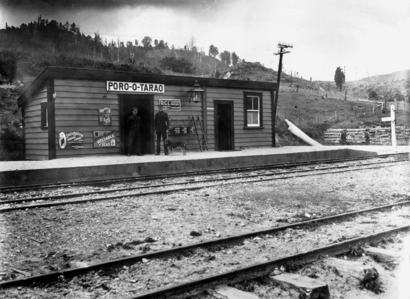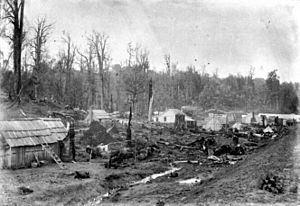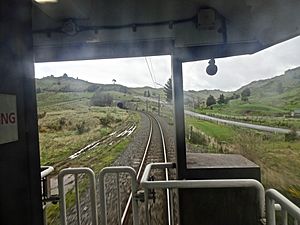Poro-O-Tarao railway station facts for kids
Quick facts for kids
Poro-O-Tarao railway station
|
|||||||||||
|---|---|---|---|---|---|---|---|---|---|---|---|

Poro-O-Tarao railway station about 1910
|
|||||||||||
| Location | New Zealand | ||||||||||
| Coordinates | 38°32′59″S 175°18′51″E / 38.549743°S 175.314288°E | ||||||||||
| Elevation | 339 m (1,112 ft) | ||||||||||
| Line(s) | North Island Main Trunk | ||||||||||
| Distance | Wellington 443.58 km (275.63 mi) | ||||||||||
| History | |||||||||||
| Opened | 1 April 1901 | ||||||||||
| Closed | 10 May 1976 | ||||||||||
| Electrified | June 1988 | ||||||||||
| Services | |||||||||||
|
|||||||||||
Poro-O-Tarao (also called Porootarao) was a small train station in the Waitomo District of New Zealand. It was a "flag station," meaning trains only stopped if someone waved a flag or wanted to get off. This station was on the important North Island Main Trunk (NIMT) railway line.
The railway line here runs between the Mōkau and Whanganui rivers. The NIMT goes through the Poro-O-Tarao tunnel, which is under Tihikārearea hill. After the tunnel, the line goes down into the Ōngarue valley.
For two years, from April 1, 1901, Poro-O-Tarao was the very end of the railway line coming from Auckland. The tracks actually reached Poro-O-Tarao earlier, on December 1, 1896. From January 18, 1897, a weekly goods train started running from Puketutu to Poro-O-Tarao.
Work on this part of the railway began in September 1892. The section from Mōkau station to the Poro-O-Tarao tunnel officially opened for trains on December 21, 1896. The station itself opened on April 1, 1901.
The station stopped handling goods in 1976. However, it stayed open for the Ministry of Works until November 10, 1980. This was while a new tunnel was being built. There was also another station nearby called Porootarao South, which was open from about 1898 to 1902.
Contents
The Poro-O-Tarao Tunnel
The Poro-O-Tarao tunnel is located just south of where the station used to be. It was about 1.07 kilometers (0.66 miles) long. The government gave a contract to build this section, including the tunnel, in August 1885.
Building the First Tunnel
Construction on the tunnel started in 1886. It was finished by August 27, 1890.
The local Māori leader, Te Ihingarangi, had been promised the railway would go around Tihikārearea hill. This hill was very important because it had 23 sacred healing trees and other tapu (sacred) sites. Local Māori groups only found out about the government's plan to build the railway straight through Tihikārearea when workers arrived in 1886.
They told the workers not to build the track through their sacred land. Tohunga (Māori spiritual experts) placed sacred poles in the railway's path. Sadly, the sacred trees were cut down before the tohunga could remove the tapu. It was believed this caused health problems for people. The trees were used to make railway sleepers. Also, the construction polluted a puna wai tapu (holy spring) where tohunga lived.
Tunnel Problems and Repairs
Poro-O-Tarao was one of the smallest tunnels on the North Island Main Trunk line. Because of its size, the bottom of the tunnel had to be lowered before 1920. This was done to allow larger trains to pass through.
The tunnel was built in weak mudstone rock, and a lot of water got in. Steel supports were used to hold up the walls. But these supports sometimes failed, and the tunnel's drainage system had problems. This caused the brickwork inside the tunnel to crack a lot.
In 1934, a 45-meter (148-foot) section that was bulging was rebuilt. It was made stronger with a reinforced concrete base. In 1965, another 12-meter (39-foot) section was replaced to make more room for trains. There was a plan to make the old tunnel even bigger, but it would have taken at least nine years and cost twice as much as expected, so the idea was dropped.
Building a New Tunnel
When the railway line was electrified (meaning trains would run on electricity), a new tunnel was needed. A new, larger tunnel was built to the west of the old one. This new tunnel is 6 meters (20 feet) wide and 1,272 meters (4,173 feet) long.
This new tunnel goes through soft sedimentary rocks, including areas with landslides. The ground here is uneven, with many small slopes. When they started digging, they found weak claystone, siltstone, and sandstone. The rock layers and cracks make the rock even weaker, and water can easily get in. The southern entrance to the new tunnel is mostly unstable landslide material, made of silty clay with rock pieces.
Towards the end of building the new tunnel, there were worries that the old tunnel might collapse. It was shrinking 2-3 millimeters (0.08-0.12 inches) a year when the drainage worked well. But when the drainage failed, it shrank 8-10 millimeters (0.31-0.39 inches) a year. The main drain in the tunnel had blocked, and some steel supports were bending. It was so bad that a plan was made in case the old tunnel collapsed and needed to be reopened. Luckily, this plan was never needed.




